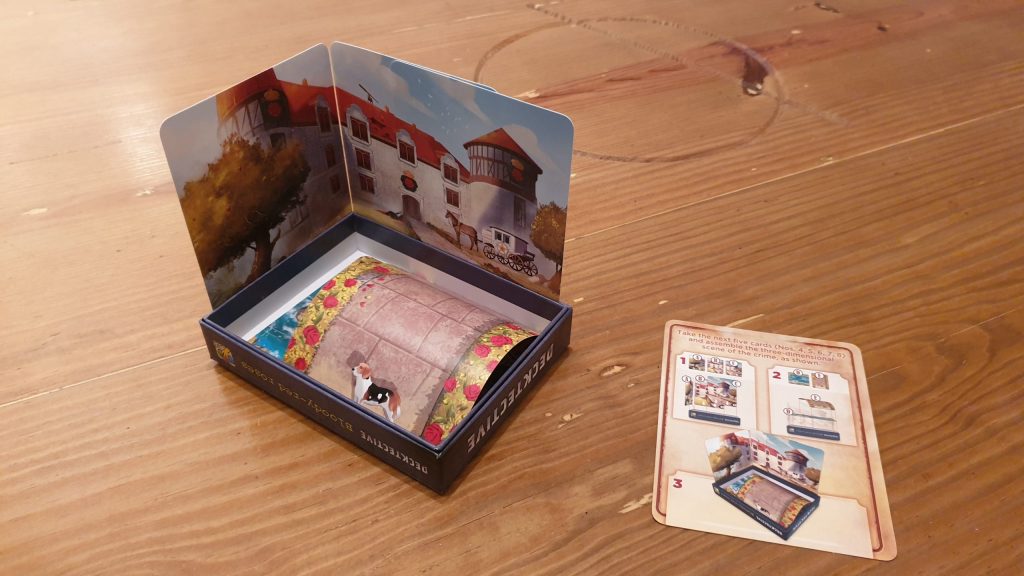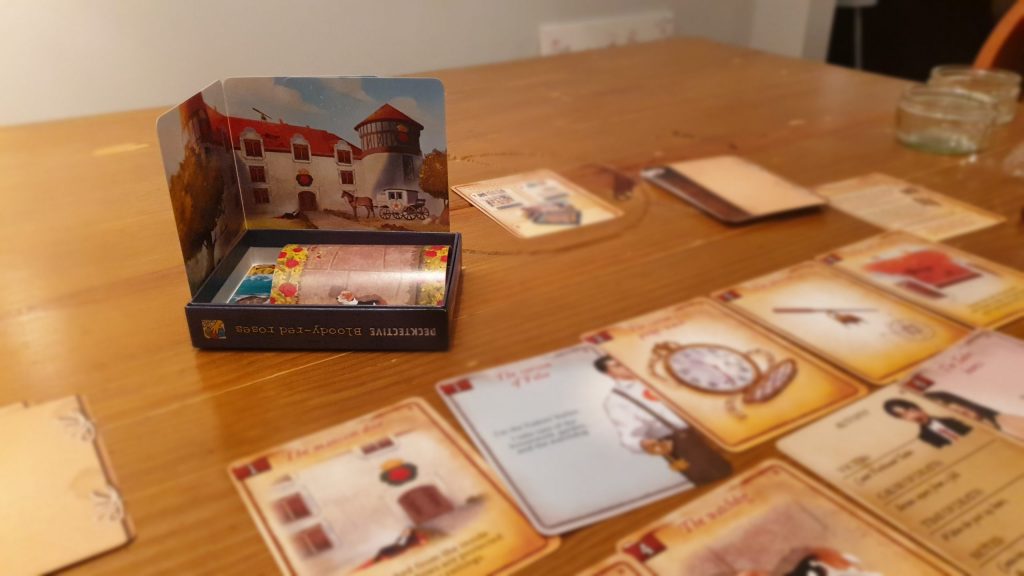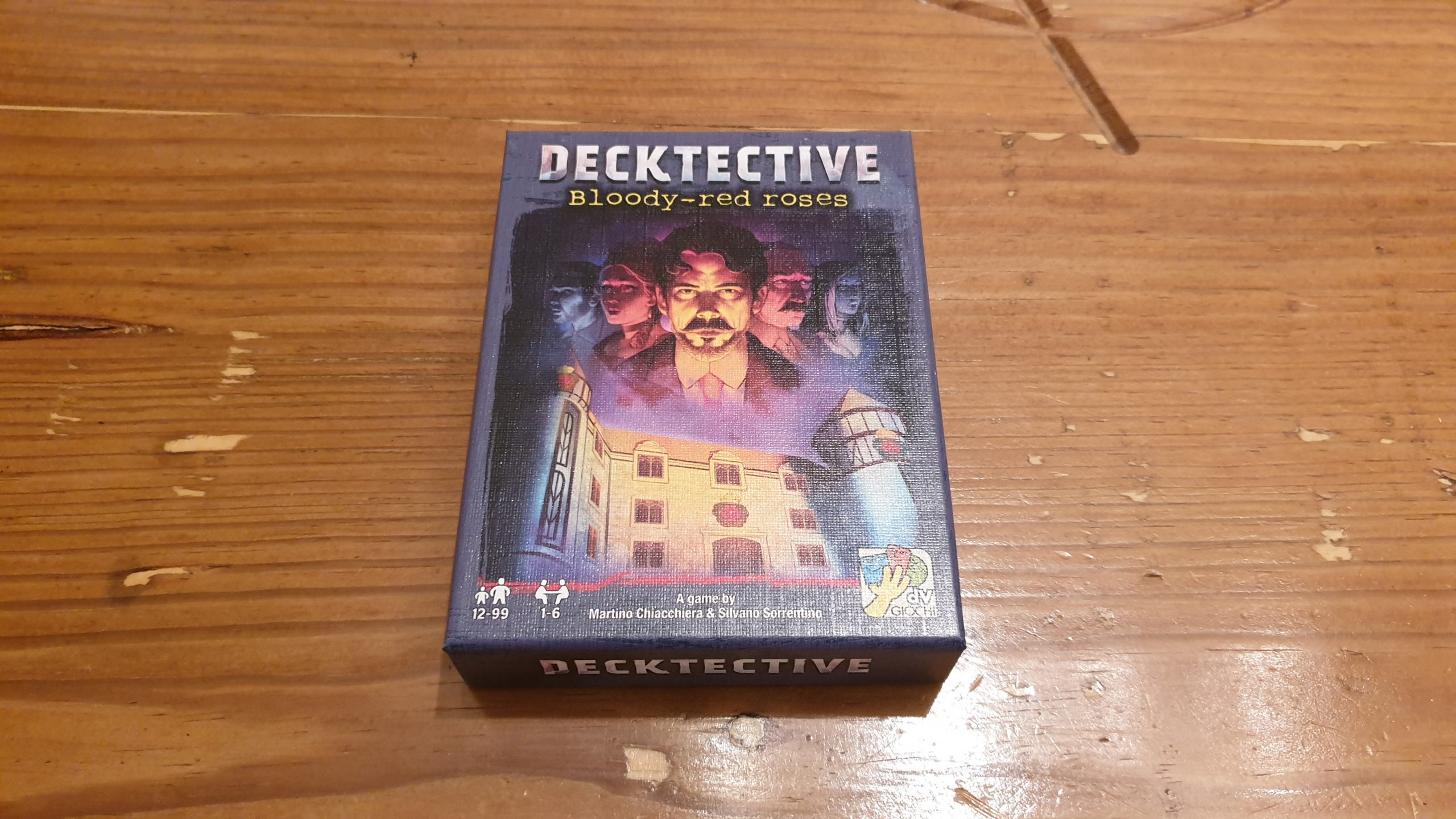Decktective Bloody-Red Roses is the first in a new line of one time cooperative murder mystery titles from publisher dV Giochi. Designed by Martino Chiacchiera and Silvano Sorrentino, featuring artwork from Alberto Besi, the game utilizes memory and hand management to progress the storytelling. According to the publisher this is a mystery for 1 – 6 players, with the play for the review conducted with two. However, is the Bloody-Red Roses mystery bloody good? Let’s find out!
Note: Any images of the game in the review are of components shown on the back of the box or with blurred cards so text is not legible.
Starting the adventure off the introduction cards set the scene. The Duke of York has arrived at the Tudor family mansion to find the Count, Ferdinand Tudor, lifeless in a bush of bloody roses. From here, investigators arrive – with the investigators being the players. Players will attempt to piece together clues to work out what happened to the Count, what the motives were and unravel the story.
In a change from the norm, players can see the described scene, adding to the narrative. This is the hook of the experience as the scene isn’t just written on cards. Instead, it is made from them in 3 dimensions in front of the players, after following the instructions on the cards. This all happens before the core of the game, where the search for clues begins. It is both an engaging way to tell the plot but also to make what is effectively a rules explanation and setup feel included.

To start the clue section off each player draws a number of cards, the amount dependant on the player count. Each player is free to look at their own cards but cannot reveal what the cards depict. In turn, each player is given a choice. Either the player archives a card or plays a card. These are somewhat interlinked actions. Each card has a value on it. To be played the team must collectively have at least that number of cards archived. When played they become face up for all to see and discuss, while archived cards are played face down and cannot be.
Regardless the player draws a replacement card at the end of their go, until otherwise instructed – with play going clockwise around the table. There is very little ability to quarterback this experience, where one player takes over and tells others what they must do on their turn. Only the individual players can determine how useful their clues may be to the group and act accordingly.
When most of the way through the deck the clue cards stop, with a final few turns left for players – which are taken as normal. Once all clues are either played or archived it is time to discuss what knowledge is available. Using the clues players then must answer a set of questions. Unlike some one time adventures, there are no different outcomes but players do get a rating on how much they get right.
Explanations on how players could have worked out the correct information are also included after the questions, so no one is left with loose ends. This being said, Decktective Bloody-Red Roses wasn’t an overly difficult experience. Lasting just over 30 minutes with 2 players it wasn’t an experience we rushed through, and we got 80% of the questions correct. For those that cannot fully commit to an hour long experience that most “similar” (escape room/adventure like) games offer this could be ideal. However, for others is does just mean a shorter experience from a deck that is about the same size.

The feeling of knowing half of the information (with 2 players) is an interesting twist. It makes each decision you make feel important as you partially rely on your teammate to help out, either with a great clue or archiving to allow you to play something. Naturally the amount of knowledge would become less as more players get involved. Splitting the information across more players will be seen more favourably by some more than others. One problem I do have with the claimed 1 – 6 player count though is not the upper end: even if 5 – 6 players are far from my preferred way to play. While the box suggests Decktective can be played solo this information sharing is one aspect that would break, and would be missed.
The deck of cards features artwork of the scene, single objects or scraps of information. What each card depicts is clear, as to not hinder the clue based puzzle. Still, the opportunity for solid artwork on each has been seized. In comparison to the standout flair element, the 3D crime scene, the rest is good but has less to get excited by. Size wise the cards are larger in size than a normal playing card, but you won’t be shuffling this deck – so it is a nicety not a problem.
When answering questions clips are used to lock in answers. If you leave these on they may slightly bend the cards, making it obvious what you choose once they are removed. As players will only want to play this through once it isn’t an imminent issue. At least until you pass Decktective Bloody-Red Roses on to a friend to play. This is a fully resettable experience, with this just being something to watch out for.
The simple rules, which are neatly explained on the introduction cards, result in a deck of cards that provides no additional barriers to entry. Simply unbox the game and seconds later two or more players can be fully wrapped up in the experience. While it felt a little easy, we didn’t get the questions 100% correct. It is more that the answers we did get right we were in no doubt about. Despite this ease the solving element still felt successful, though probably contributed to the short 30 minute play time. If you’re okay with that short play time Decktective Bloody-Red Roses is an enjoyable experience, and certainly makes me excited for future adventures in the series.
(Editor’s Note: Decktective Bloody-Red Roses was provided to us by dV Giochi for the review at Essen Spiel 2019)

